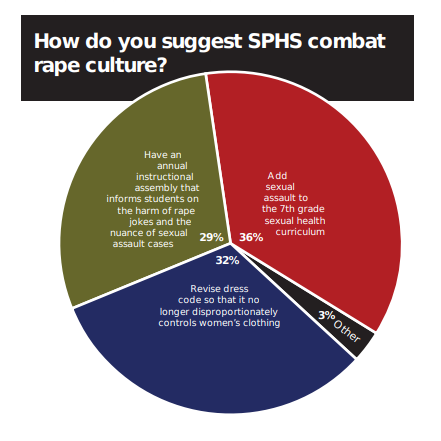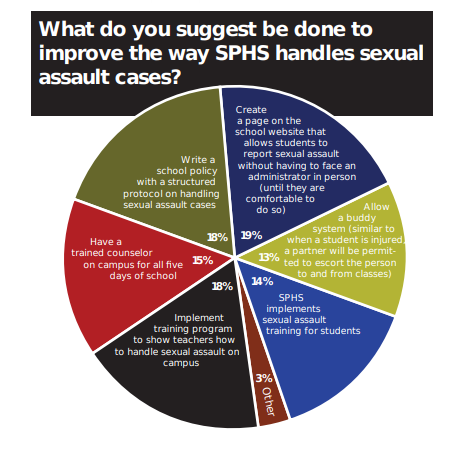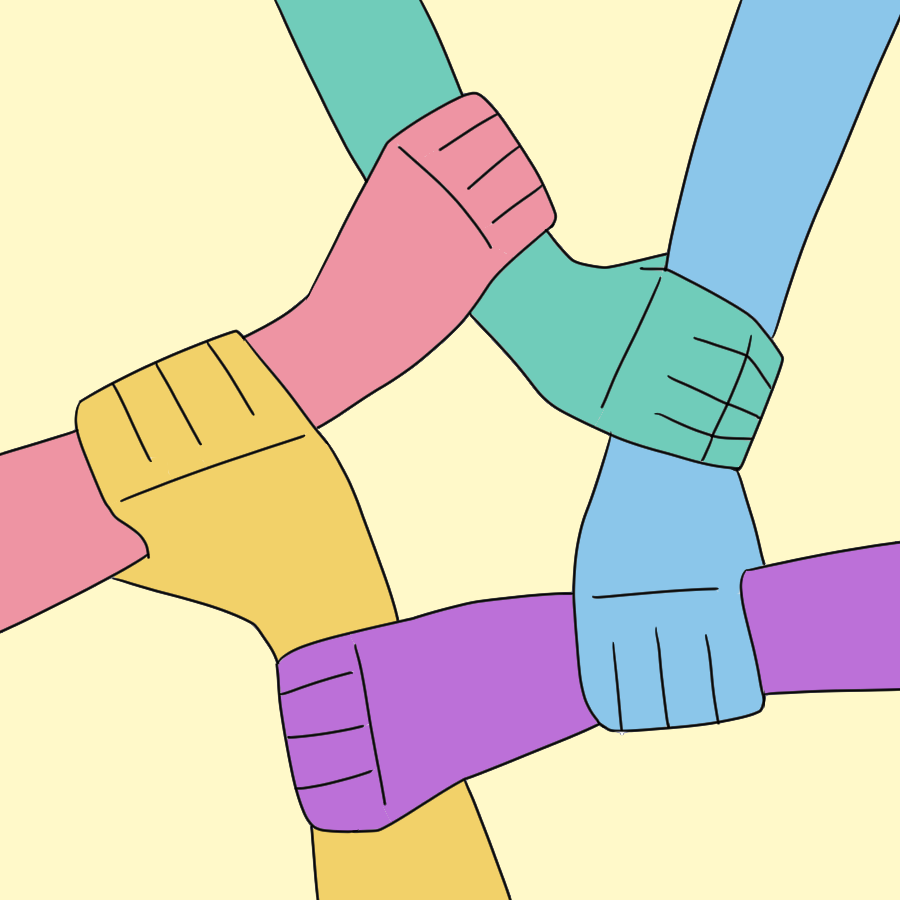Story by Georgia Parsons & Quinn Manzo
Associate Feature Editor & Staff Writer
Illustration by Tarry Song
Associate Design Editor
Currently, the school has a series of protocols in place along with resources for survivors of sexual misconduct. The overarching procedure is Title IX, which ensures quality of education as one of several federal and state anti-discrimination laws.
The procedure includes a non-discrimination statute that states that discrimination, harassment, exclusion, denial, limitation, or separation based on sex or gender is prohibited in learning environments. The Title IX document on the school’s website goes through the complaint process in the case of sexual misconduct. If a student or their guardian wants to report a Title IX complaint, they must seek an administrator or the Title IX coordinator, Dr. Karen Reed, within six months of the incident. The student or their guardian may file a Uniform Complaint Procedures (UCP) complaint to the District’s Complaint Coordinator if they are dissatisfied with the decision of administration or the Title IX coordinator, which will launch an investigation that must be completed within 60 days. The School Resource Officer, Detective Tyler Borrello, assists with school activities and conducts juvenile investigations.
When observed outside of a court setting, the extremely wordy laws are difficult to understand. Yet, students deserve to know their rights, therefore administration must widely distribute a digestible summary of Title IX. This will ensure that students are well-informed of their own as well as the school’s rights regarding sexual discrimination and sexual misconduct cases.
In their policy on sexual harassment, the School Board prohibits sexual harassment at school-sponsored or school-related activities as well as the harassment of those who come forward with complaints of sexual harassment. It also ensures that the superintendent or designee will deliver age-appropriate information about sexual harassment — information that most SPHS students cannot recall receiving.
The board’s nondiscrimination/harassment policy aims to prevent unlawful discrimination by publicizing the school’s policies and complaint process, in an attempt to ensure that all students are aware of them. Yet, Tiger was only made aware of these policies when seeking comment on sexual misconduct cases. It also aims to “provide a safe school environment that allows all students equal access and opportunities in the district’s academic, extracurricular, and other educational support programs, services, and activities.”
In addition to the Title IX requirements, SPHS recently formed a connection with the company Care Solace that offers a 24/7 concierge for students to find mental health support near their location. The partnership itself has been poorly advertised via outreach methods that have already been expressed by students to be ineffective. On top of poor outreach methods, Care Solace has failed to take off as a go-to student resource because the company does not offer direct and immediate support; it can only refer students to appropriate mental health resources.
The only dedicated professional mental health resource on campus for the general student body is Ms Prime. When school is in person, she is on campus three days a week, and her services are shared between the high school and middle school. However, during distance learning, she is available more often, offering appointments five days a week.
Teachers must also go through annual sexual harassment and discrimination training. Under legislation passed in the State of California in 2018, any person working full time must take a sexual harassment prevention course. This course requires that all non-supervisory employees take one hour of training, and all supervisors must take two hours of training based on the SB 1343 employee harassment training law. The instructional material covers the federal and statewide ban on sexual harassment, guidance on sexual harassment prevention, abusive conduct prevention, corrective actions against harassers, and how to support those who have been victims of harassment. The annual training is in addition to requirements for a teaching credential, in which an individual must disclose any incidences of misconduct in their application. Seasonal or temporary staff members must also complete their non-supervisory training within the first 30 days or 100 completed hours of work.
With these expansive resources and procedures put in place, why are students still left feeling unsupported?
Much of student distrust in regards to sexual misconduct cases stems from a divide in communication between the student body and school administration. This divide was evident in Kan’s case referenced in part one, in which the understanding of what had happened to [the district employee] contradicted administration’s. Based on Kan’s account, [the district employee] received little to no punishment. Yet, administration wasn’t able to clarify what that punishment was. This lack of transparency perpetuates the distrust students have in administration.
The student body is well aware of the countless laws and restrictions regarding confidentiality that prevent school administrations from disclosing everything and anything to the community. The school should not break these restrictions for the sole sake of comforting students. What the school should do, however, is communicate with the student body and be forthcoming to the absolute fullest extent possible. When there is a serious sexual assault investigation going on, let the community know; of course, in adherence to confidentiality laws.
Administration should release these announcements on social media, because it is the most accessible communication platform for students. Many students, parents, and staff receive hundreds of emails per day and the school announcements containing important information get buried among other messages.
The school underestimates how reassuring announcements of ongoing sexual misconduct investigations would be. They would prove that the school isn’t trying to hide sexual misconduct cases to salvage it’s reputation, and they would emulate a sense of unity, asserting that it is the school versus the problem, instead of the student body versus administration.
SPUSD needs to clarify the difference between the actions it takes versus the actions outsourced to law enforcement. When both the school administration and a School Resource Officer get involved, the line between the school justice system and that of the police department blurs. When an anonymous SPHS alumnus reported their sexual assault directly to the South Pasadena Police Department, an officer visited SPHS and pulled them out of class multiple times to discuss the police report.
“They used to pull me out of class to talk about my case even though my assaulter didn’t go to South Pas, [which] most likely means all the office staff knew something happened to me,” the anonymous alumnus said. “Once, it happened after [a school performance].”
Forming a more emotionally supportive staff is also a necessary measure that must be taken. Ms. Prime should be hired full-time and additional mental health professionals should be hired on staff. Obtaining the right elements to heal after experiencing something traumatic is just as, if not more, important as seeking legal repercussions for the aggressor. By having more mental health professionals on staff, survivors will have advocates on campus whether or not they choose to proceed with the long, tedious, and stressful process of filing a legal report.
The student body is also partly responsible for the unsupportive environment on campus and their ignorance of sexual violence and consent is evidence of the fact that SPUSD does not meet Title IX’s requirement of age-appropriate information about sexual misconduct. Without coherent sex education for students in the early years of high school and middle school, survivors of sexual misconduct are alienated by their peers, who most of which do not have a significant understanding of the gravity sexual assault and harassment.
An anonymous alum described a moment during school where their friends spoke extremely insensitively towards them about their sexual assault experience: “In junior year we watched a TED talk that mentioned sexual assault and sex trafficking, so I said to [the teacher] that I had to leave which he let me do… At lunch, I see my so-called friends of that time and I told them I was having a PTSD attack to which they said ‘That’s ridiculous, they didn’t even say what happened to you, how can you be that anxious?’”

This example is an individual manifestation of rape culture that remains pervasive due to the school’s lack of cohesive sexual misconduct training for students, especially in regards to how one should handle its effects in relation to their peers. On an individual level, rape culture is combatted when a staunchly non-apologist approach is taken towards reforming how sexual assault is handled. Students cannot remain neutral. They cannot stay friends with both the abuser and the victim because it implies that the action was not grave enough to take seriously.
On a school wide level, SPHS must remove perpetrators from any extracurriculars that might bring them in contact with the victim. Those accused of sexual misconduct should also be removed from leadership positions, including coaches, as those in a position of leadership represent the school and therefore represent the values that SPHS should uphold.

Right now, in order for a survivor’s sexual misconduct case to be seen as valid and legitimate, the survivor has to be the “perfect victim,” one that only seeks the guidance of administration and law enforcement rather than complicating their story with social media. But, social media has become such a safe space for so many teenagers, providing them the ability to control their narrative. Administration would be completely unwise to expect teenagers to stop seeking justice on public platforms, even with policy reform.
The goal of policy reform should not be to increase the likelihood of students bypassing social media in favor of the administrative process; the goal should be to broaden the safety net for the survivor, validating and supporting the survivor no matter how or where they share their story.



